Factors Influencing Wound Healing: A Nursing Perspective
VerifiedAdded on 2022/11/22
|7
|1725
|206
Essay
AI Summary
This essay delves into the multifaceted process of wound healing, focusing on two key influencing factors: age and diabetes. It explores how these factors impact the speed and effectiveness of wound recovery, highlighting the physiological changes associated with aging and the complications that arise from diabetes. The essay further examines various strategies to assist in wound healing, including the importance of maintaining blood glucose levels, proper foot care for diabetic patients, and the significance of nutrition and physical activity. It then transitions to a discussion of wound dressing, comparing traditional and modern approaches and emphasizing the cultural considerations in selecting appropriate dressings. Finally, the essay incorporates Gibbs' reflective cycle to analyze the learning experience and the importance of wound care and dressing in nursing practice, concluding with insights gained and future practice implications.
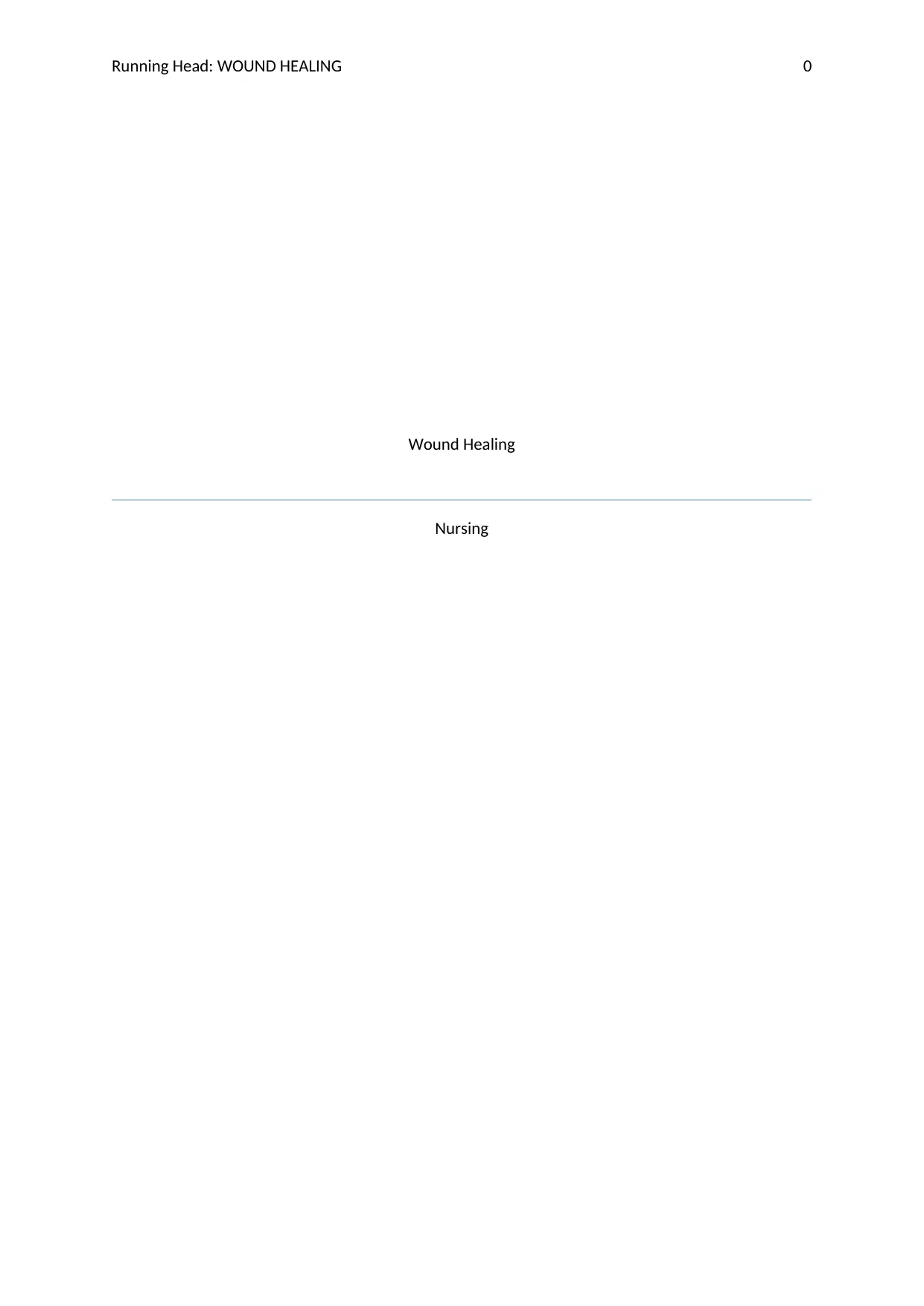
Running Head: WOUND HEALING 0
Wound Healing
Nursing
Wound Healing
Nursing
Paraphrase This Document
Need a fresh take? Get an instant paraphrase of this document with our AI Paraphraser
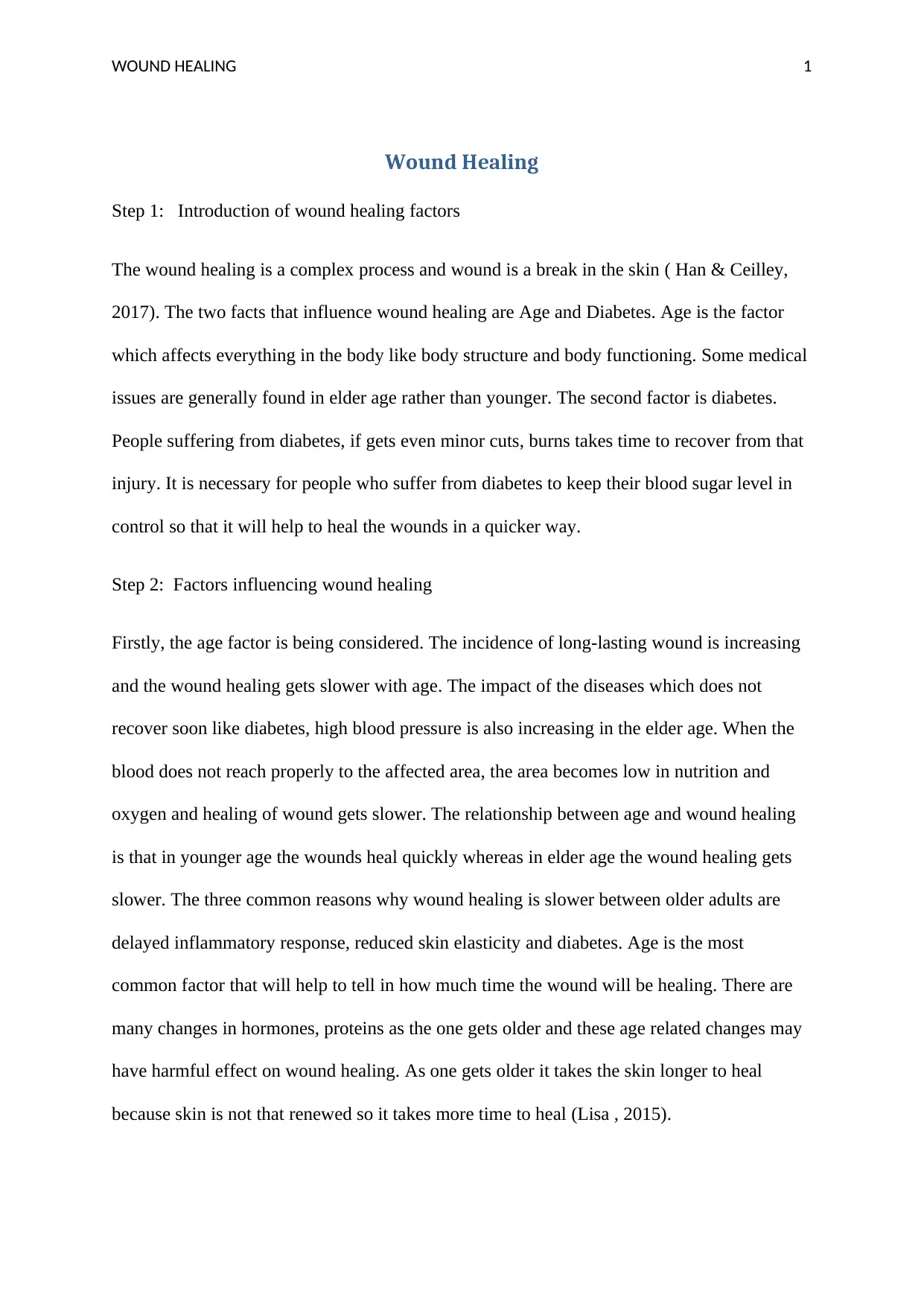
WOUND HEALING 1
Wound Healing
Step 1: Introduction of wound healing factors
The wound healing is a complex process and wound is a break in the skin ( Han & Ceilley,
2017). The two facts that influence wound healing are Age and Diabetes. Age is the factor
which affects everything in the body like body structure and body functioning. Some medical
issues are generally found in elder age rather than younger. The second factor is diabetes.
People suffering from diabetes, if gets even minor cuts, burns takes time to recover from that
injury. It is necessary for people who suffer from diabetes to keep their blood sugar level in
control so that it will help to heal the wounds in a quicker way.
Step 2: Factors influencing wound healing
Firstly, the age factor is being considered. The incidence of long-lasting wound is increasing
and the wound healing gets slower with age. The impact of the diseases which does not
recover soon like diabetes, high blood pressure is also increasing in the elder age. When the
blood does not reach properly to the affected area, the area becomes low in nutrition and
oxygen and healing of wound gets slower. The relationship between age and wound healing
is that in younger age the wounds heal quickly whereas in elder age the wound healing gets
slower. The three common reasons why wound healing is slower between older adults are
delayed inflammatory response, reduced skin elasticity and diabetes. Age is the most
common factor that will help to tell in how much time the wound will be healing. There are
many changes in hormones, proteins as the one gets older and these age related changes may
have harmful effect on wound healing. As one gets older it takes the skin longer to heal
because skin is not that renewed so it takes more time to heal (Lisa , 2015).
Wound Healing
Step 1: Introduction of wound healing factors
The wound healing is a complex process and wound is a break in the skin ( Han & Ceilley,
2017). The two facts that influence wound healing are Age and Diabetes. Age is the factor
which affects everything in the body like body structure and body functioning. Some medical
issues are generally found in elder age rather than younger. The second factor is diabetes.
People suffering from diabetes, if gets even minor cuts, burns takes time to recover from that
injury. It is necessary for people who suffer from diabetes to keep their blood sugar level in
control so that it will help to heal the wounds in a quicker way.
Step 2: Factors influencing wound healing
Firstly, the age factor is being considered. The incidence of long-lasting wound is increasing
and the wound healing gets slower with age. The impact of the diseases which does not
recover soon like diabetes, high blood pressure is also increasing in the elder age. When the
blood does not reach properly to the affected area, the area becomes low in nutrition and
oxygen and healing of wound gets slower. The relationship between age and wound healing
is that in younger age the wounds heal quickly whereas in elder age the wound healing gets
slower. The three common reasons why wound healing is slower between older adults are
delayed inflammatory response, reduced skin elasticity and diabetes. Age is the most
common factor that will help to tell in how much time the wound will be healing. There are
many changes in hormones, proteins as the one gets older and these age related changes may
have harmful effect on wound healing. As one gets older it takes the skin longer to heal
because skin is not that renewed so it takes more time to heal (Lisa , 2015).
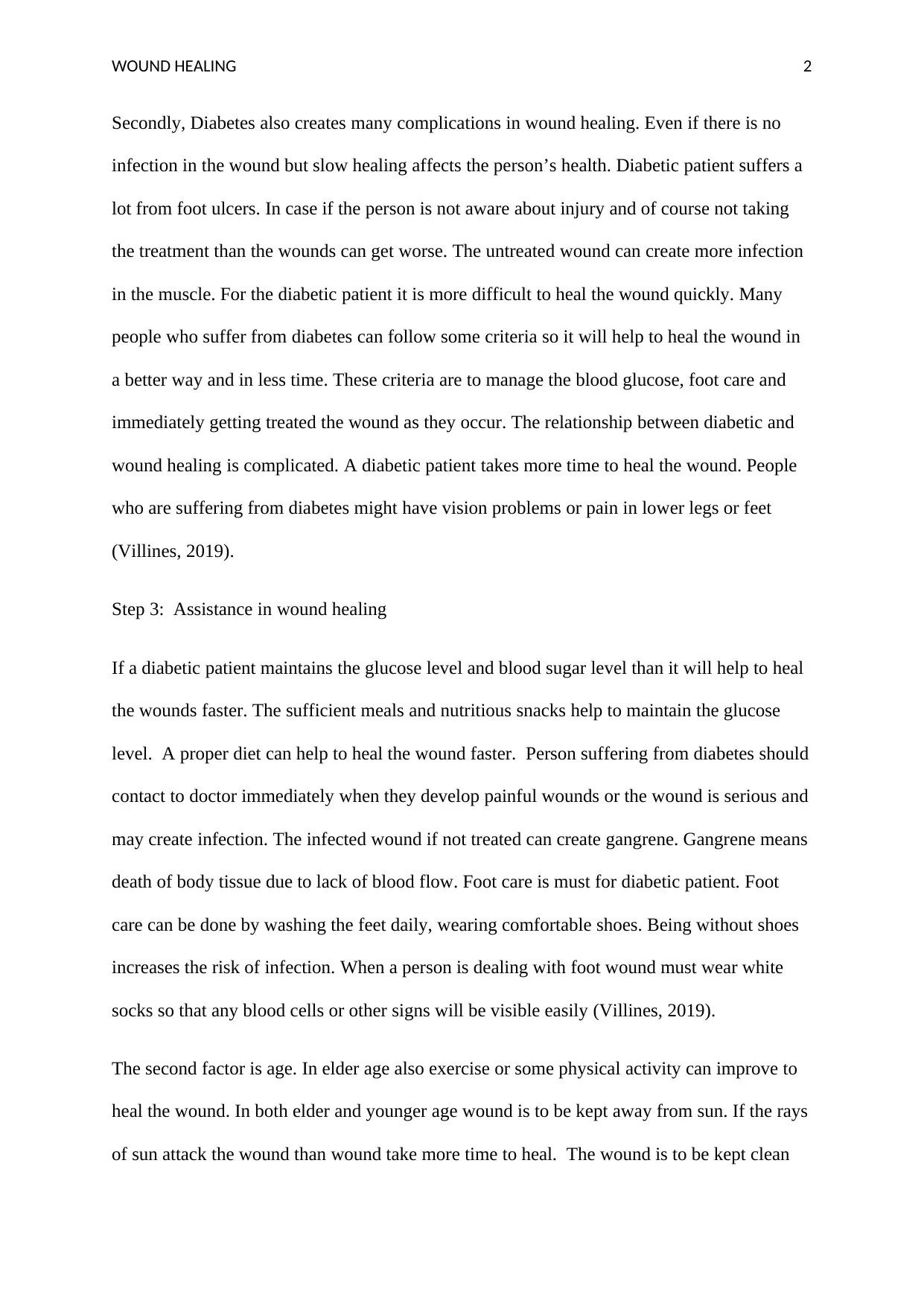
WOUND HEALING 2
Secondly, Diabetes also creates many complications in wound healing. Even if there is no
infection in the wound but slow healing affects the person’s health. Diabetic patient suffers a
lot from foot ulcers. In case if the person is not aware about injury and of course not taking
the treatment than the wounds can get worse. The untreated wound can create more infection
in the muscle. For the diabetic patient it is more difficult to heal the wound quickly. Many
people who suffer from diabetes can follow some criteria so it will help to heal the wound in
a better way and in less time. These criteria are to manage the blood glucose, foot care and
immediately getting treated the wound as they occur. The relationship between diabetic and
wound healing is complicated. A diabetic patient takes more time to heal the wound. People
who are suffering from diabetes might have vision problems or pain in lower legs or feet
(Villines, 2019).
Step 3: Assistance in wound healing
If a diabetic patient maintains the glucose level and blood sugar level than it will help to heal
the wounds faster. The sufficient meals and nutritious snacks help to maintain the glucose
level. A proper diet can help to heal the wound faster. Person suffering from diabetes should
contact to doctor immediately when they develop painful wounds or the wound is serious and
may create infection. The infected wound if not treated can create gangrene. Gangrene means
death of body tissue due to lack of blood flow. Foot care is must for diabetic patient. Foot
care can be done by washing the feet daily, wearing comfortable shoes. Being without shoes
increases the risk of infection. When a person is dealing with foot wound must wear white
socks so that any blood cells or other signs will be visible easily (Villines, 2019).
The second factor is age. In elder age also exercise or some physical activity can improve to
heal the wound. In both elder and younger age wound is to be kept away from sun. If the rays
of sun attack the wound than wound take more time to heal. The wound is to be kept clean
Secondly, Diabetes also creates many complications in wound healing. Even if there is no
infection in the wound but slow healing affects the person’s health. Diabetic patient suffers a
lot from foot ulcers. In case if the person is not aware about injury and of course not taking
the treatment than the wounds can get worse. The untreated wound can create more infection
in the muscle. For the diabetic patient it is more difficult to heal the wound quickly. Many
people who suffer from diabetes can follow some criteria so it will help to heal the wound in
a better way and in less time. These criteria are to manage the blood glucose, foot care and
immediately getting treated the wound as they occur. The relationship between diabetic and
wound healing is complicated. A diabetic patient takes more time to heal the wound. People
who are suffering from diabetes might have vision problems or pain in lower legs or feet
(Villines, 2019).
Step 3: Assistance in wound healing
If a diabetic patient maintains the glucose level and blood sugar level than it will help to heal
the wounds faster. The sufficient meals and nutritious snacks help to maintain the glucose
level. A proper diet can help to heal the wound faster. Person suffering from diabetes should
contact to doctor immediately when they develop painful wounds or the wound is serious and
may create infection. The infected wound if not treated can create gangrene. Gangrene means
death of body tissue due to lack of blood flow. Foot care is must for diabetic patient. Foot
care can be done by washing the feet daily, wearing comfortable shoes. Being without shoes
increases the risk of infection. When a person is dealing with foot wound must wear white
socks so that any blood cells or other signs will be visible easily (Villines, 2019).
The second factor is age. In elder age also exercise or some physical activity can improve to
heal the wound. In both elder and younger age wound is to be kept away from sun. If the rays
of sun attack the wound than wound take more time to heal. The wound is to be kept clean
⊘ This is a preview!⊘
Do you want full access?
Subscribe today to unlock all pages.

Trusted by 1+ million students worldwide
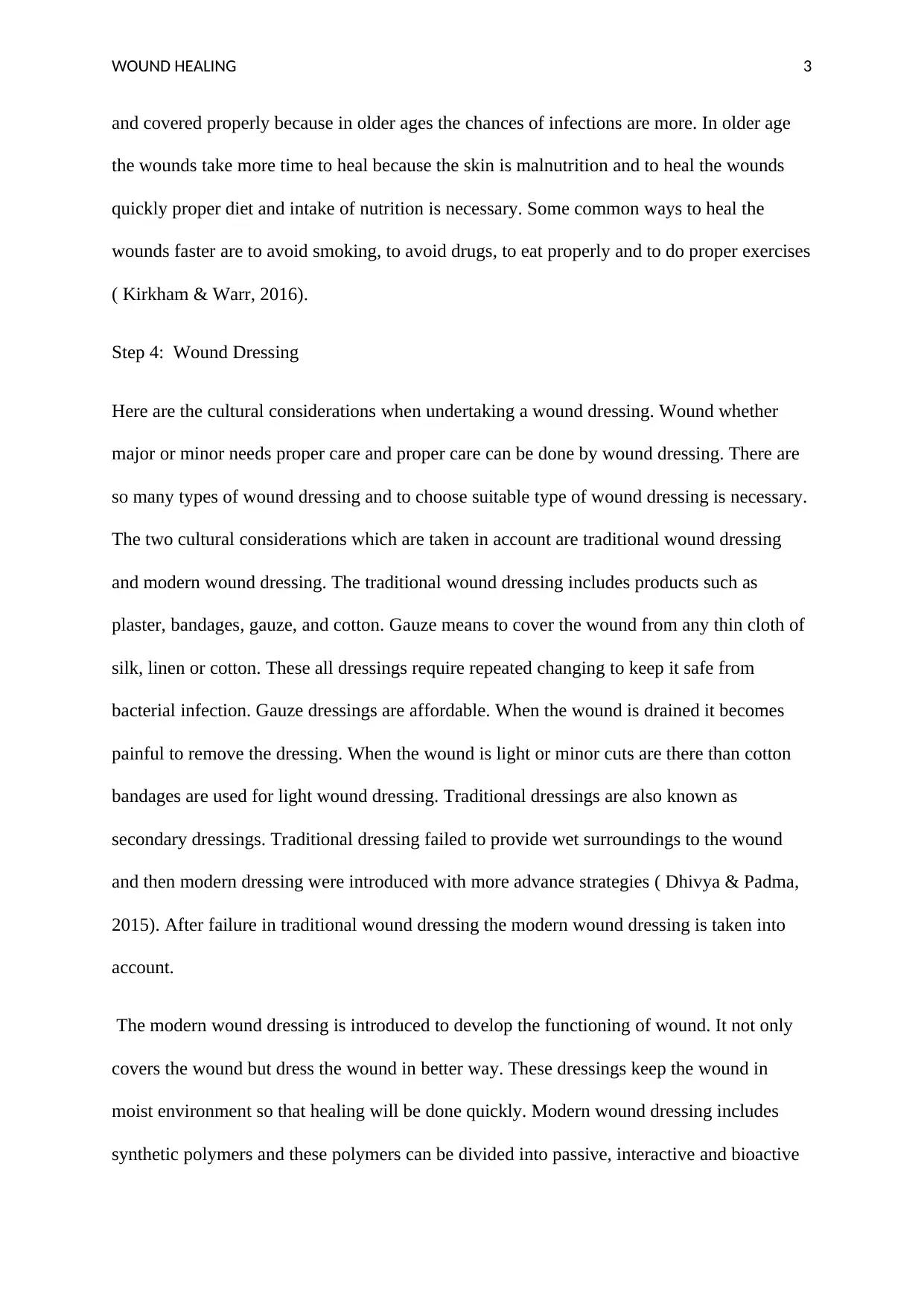
WOUND HEALING 3
and covered properly because in older ages the chances of infections are more. In older age
the wounds take more time to heal because the skin is malnutrition and to heal the wounds
quickly proper diet and intake of nutrition is necessary. Some common ways to heal the
wounds faster are to avoid smoking, to avoid drugs, to eat properly and to do proper exercises
( Kirkham & Warr, 2016).
Step 4: Wound Dressing
Here are the cultural considerations when undertaking a wound dressing. Wound whether
major or minor needs proper care and proper care can be done by wound dressing. There are
so many types of wound dressing and to choose suitable type of wound dressing is necessary.
The two cultural considerations which are taken in account are traditional wound dressing
and modern wound dressing. The traditional wound dressing includes products such as
plaster, bandages, gauze, and cotton. Gauze means to cover the wound from any thin cloth of
silk, linen or cotton. These all dressings require repeated changing to keep it safe from
bacterial infection. Gauze dressings are affordable. When the wound is drained it becomes
painful to remove the dressing. When the wound is light or minor cuts are there than cotton
bandages are used for light wound dressing. Traditional dressings are also known as
secondary dressings. Traditional dressing failed to provide wet surroundings to the wound
and then modern dressing were introduced with more advance strategies ( Dhivya & Padma,
2015). After failure in traditional wound dressing the modern wound dressing is taken into
account.
The modern wound dressing is introduced to develop the functioning of wound. It not only
covers the wound but dress the wound in better way. These dressings keep the wound in
moist environment so that healing will be done quickly. Modern wound dressing includes
synthetic polymers and these polymers can be divided into passive, interactive and bioactive
and covered properly because in older ages the chances of infections are more. In older age
the wounds take more time to heal because the skin is malnutrition and to heal the wounds
quickly proper diet and intake of nutrition is necessary. Some common ways to heal the
wounds faster are to avoid smoking, to avoid drugs, to eat properly and to do proper exercises
( Kirkham & Warr, 2016).
Step 4: Wound Dressing
Here are the cultural considerations when undertaking a wound dressing. Wound whether
major or minor needs proper care and proper care can be done by wound dressing. There are
so many types of wound dressing and to choose suitable type of wound dressing is necessary.
The two cultural considerations which are taken in account are traditional wound dressing
and modern wound dressing. The traditional wound dressing includes products such as
plaster, bandages, gauze, and cotton. Gauze means to cover the wound from any thin cloth of
silk, linen or cotton. These all dressings require repeated changing to keep it safe from
bacterial infection. Gauze dressings are affordable. When the wound is drained it becomes
painful to remove the dressing. When the wound is light or minor cuts are there than cotton
bandages are used for light wound dressing. Traditional dressings are also known as
secondary dressings. Traditional dressing failed to provide wet surroundings to the wound
and then modern dressing were introduced with more advance strategies ( Dhivya & Padma,
2015). After failure in traditional wound dressing the modern wound dressing is taken into
account.
The modern wound dressing is introduced to develop the functioning of wound. It not only
covers the wound but dress the wound in better way. These dressings keep the wound in
moist environment so that healing will be done quickly. Modern wound dressing includes
synthetic polymers and these polymers can be divided into passive, interactive and bioactive
Paraphrase This Document
Need a fresh take? Get an instant paraphrase of this document with our AI Paraphraser
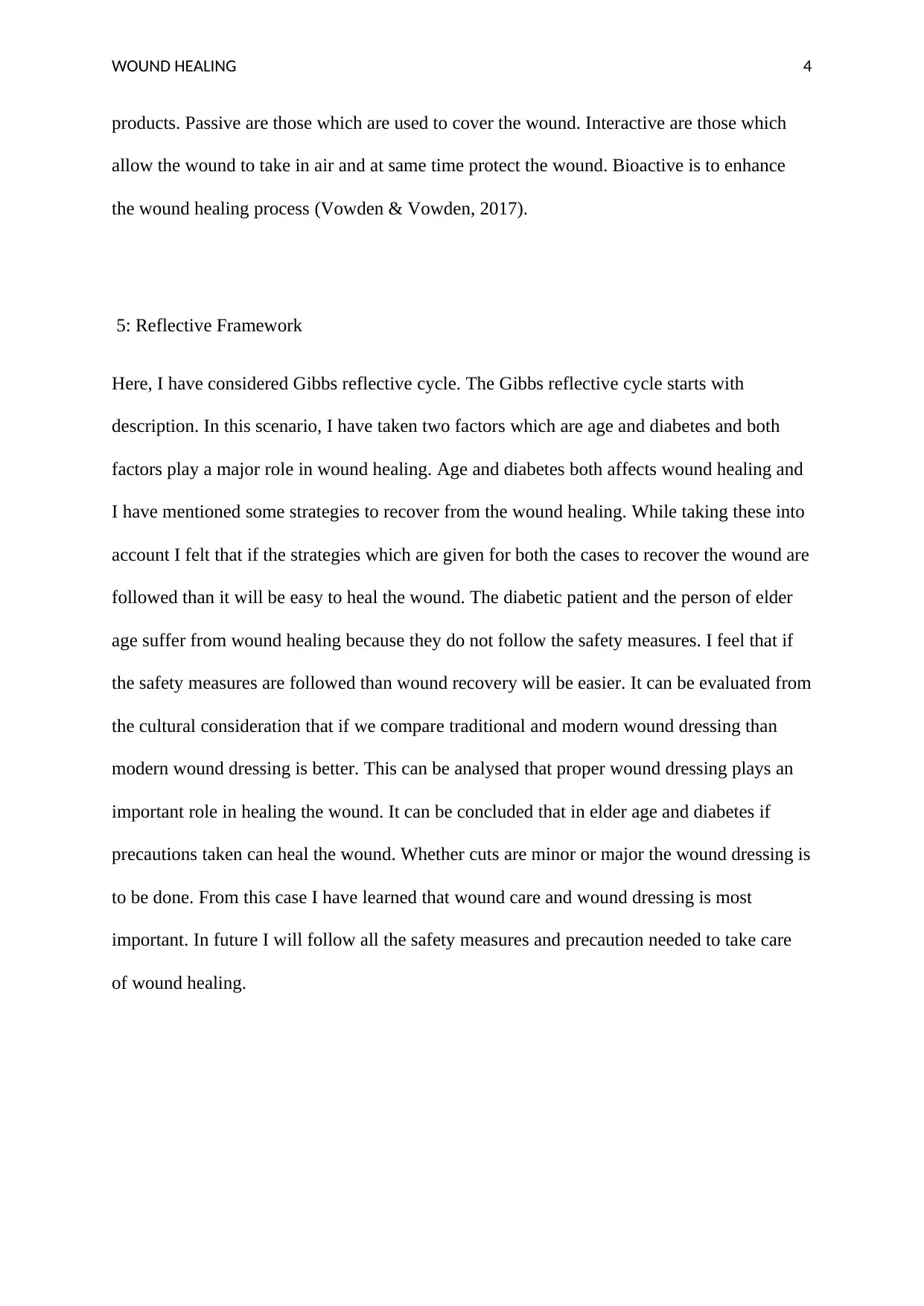
WOUND HEALING 4
products. Passive are those which are used to cover the wound. Interactive are those which
allow the wound to take in air and at same time protect the wound. Bioactive is to enhance
the wound healing process (Vowden & Vowden, 2017).
5: Reflective Framework
Here, I have considered Gibbs reflective cycle. The Gibbs reflective cycle starts with
description. In this scenario, I have taken two factors which are age and diabetes and both
factors play a major role in wound healing. Age and diabetes both affects wound healing and
I have mentioned some strategies to recover from the wound healing. While taking these into
account I felt that if the strategies which are given for both the cases to recover the wound are
followed than it will be easy to heal the wound. The diabetic patient and the person of elder
age suffer from wound healing because they do not follow the safety measures. I feel that if
the safety measures are followed than wound recovery will be easier. It can be evaluated from
the cultural consideration that if we compare traditional and modern wound dressing than
modern wound dressing is better. This can be analysed that proper wound dressing plays an
important role in healing the wound. It can be concluded that in elder age and diabetes if
precautions taken can heal the wound. Whether cuts are minor or major the wound dressing is
to be done. From this case I have learned that wound care and wound dressing is most
important. In future I will follow all the safety measures and precaution needed to take care
of wound healing.
products. Passive are those which are used to cover the wound. Interactive are those which
allow the wound to take in air and at same time protect the wound. Bioactive is to enhance
the wound healing process (Vowden & Vowden, 2017).
5: Reflective Framework
Here, I have considered Gibbs reflective cycle. The Gibbs reflective cycle starts with
description. In this scenario, I have taken two factors which are age and diabetes and both
factors play a major role in wound healing. Age and diabetes both affects wound healing and
I have mentioned some strategies to recover from the wound healing. While taking these into
account I felt that if the strategies which are given for both the cases to recover the wound are
followed than it will be easy to heal the wound. The diabetic patient and the person of elder
age suffer from wound healing because they do not follow the safety measures. I feel that if
the safety measures are followed than wound recovery will be easier. It can be evaluated from
the cultural consideration that if we compare traditional and modern wound dressing than
modern wound dressing is better. This can be analysed that proper wound dressing plays an
important role in healing the wound. It can be concluded that in elder age and diabetes if
precautions taken can heal the wound. Whether cuts are minor or major the wound dressing is
to be done. From this case I have learned that wound care and wound dressing is most
important. In future I will follow all the safety measures and precaution needed to take care
of wound healing.
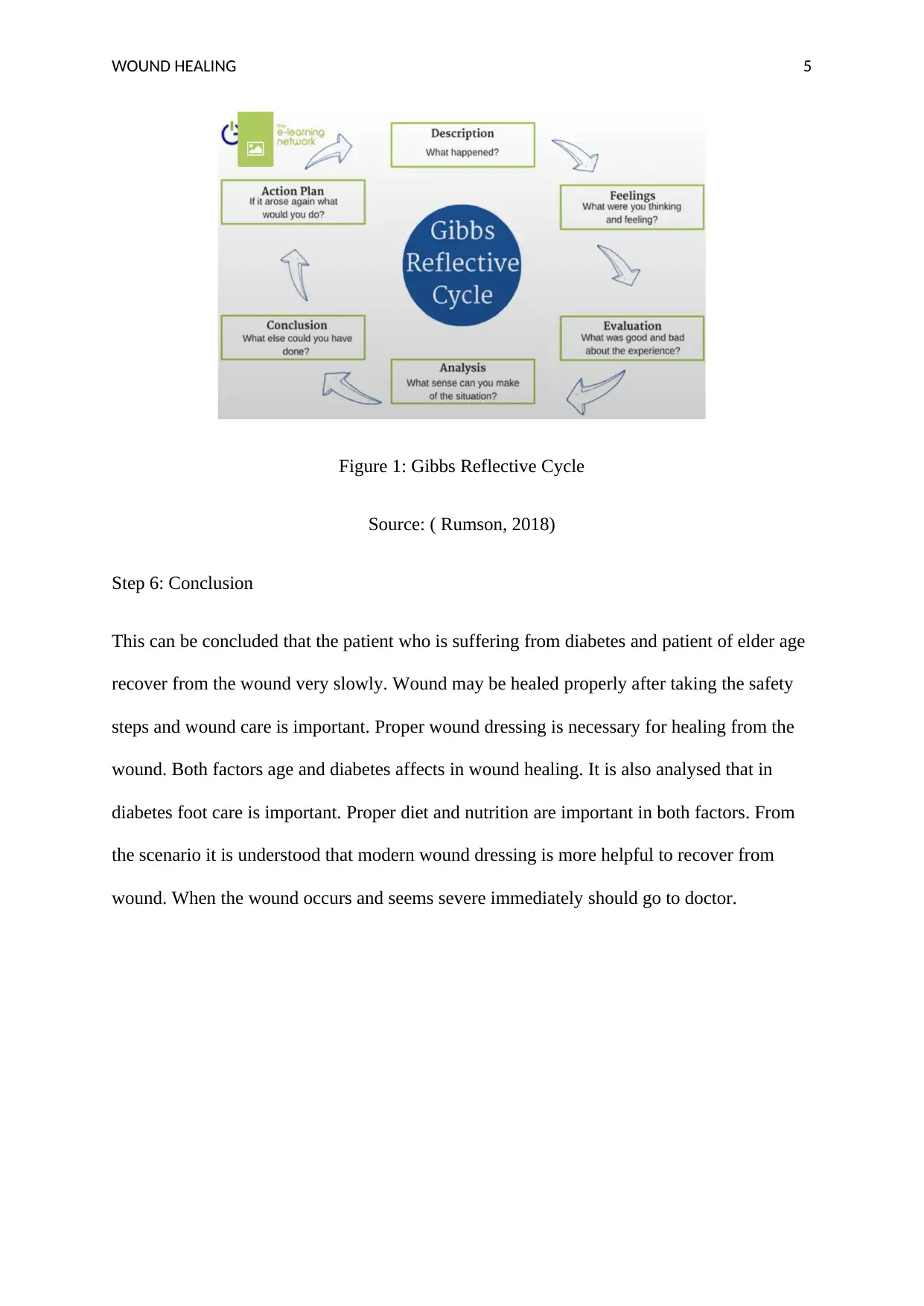
WOUND HEALING 5
Figure 1: Gibbs Reflective Cycle
Source: ( Rumson, 2018)
Step 6: Conclusion
This can be concluded that the patient who is suffering from diabetes and patient of elder age
recover from the wound very slowly. Wound may be healed properly after taking the safety
steps and wound care is important. Proper wound dressing is necessary for healing from the
wound. Both factors age and diabetes affects in wound healing. It is also analysed that in
diabetes foot care is important. Proper diet and nutrition are important in both factors. From
the scenario it is understood that modern wound dressing is more helpful to recover from
wound. When the wound occurs and seems severe immediately should go to doctor.
Figure 1: Gibbs Reflective Cycle
Source: ( Rumson, 2018)
Step 6: Conclusion
This can be concluded that the patient who is suffering from diabetes and patient of elder age
recover from the wound very slowly. Wound may be healed properly after taking the safety
steps and wound care is important. Proper wound dressing is necessary for healing from the
wound. Both factors age and diabetes affects in wound healing. It is also analysed that in
diabetes foot care is important. Proper diet and nutrition are important in both factors. From
the scenario it is understood that modern wound dressing is more helpful to recover from
wound. When the wound occurs and seems severe immediately should go to doctor.
⊘ This is a preview!⊘
Do you want full access?
Subscribe today to unlock all pages.

Trusted by 1+ million students worldwide
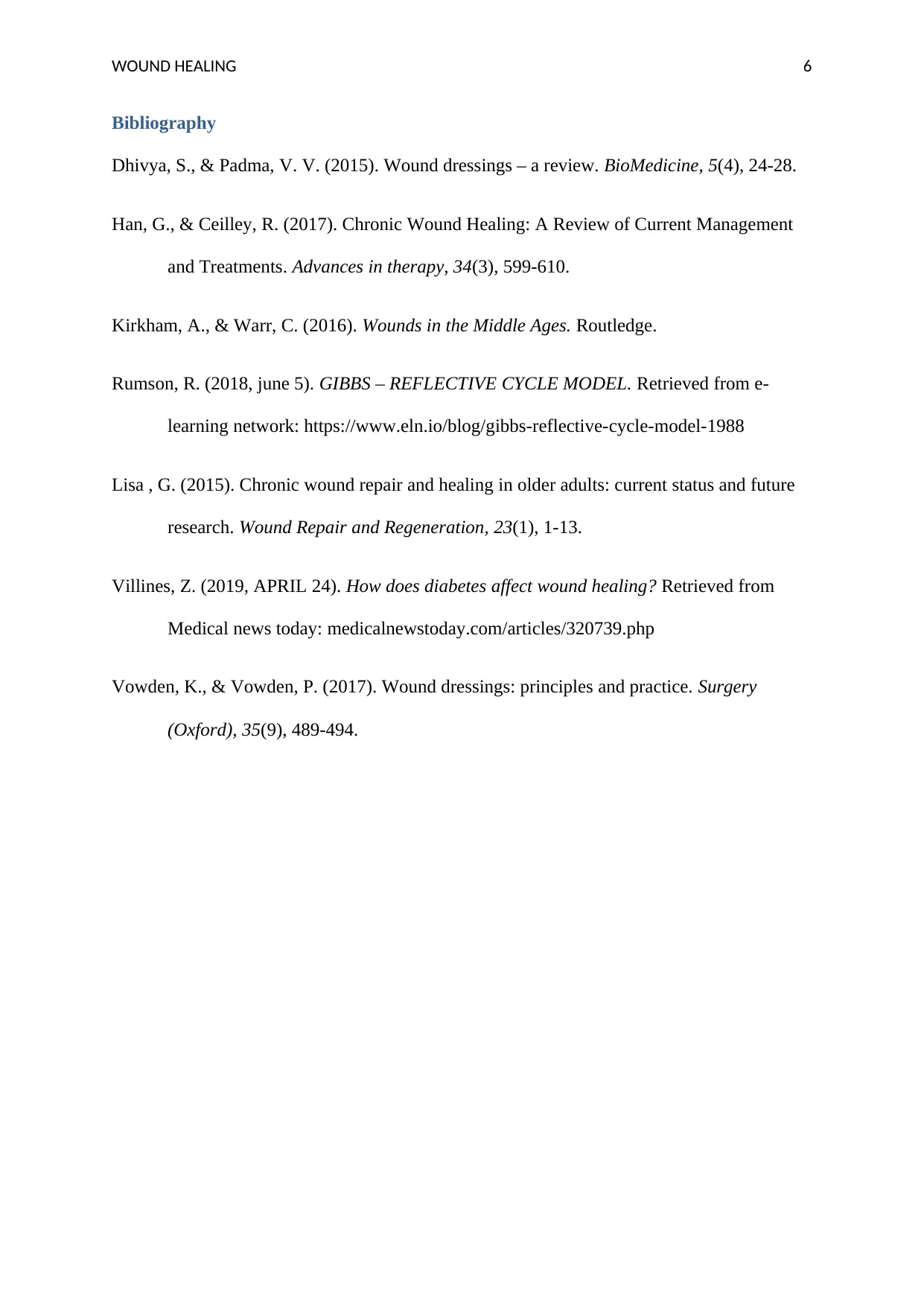
WOUND HEALING 6
Bibliography
Dhivya, S., & Padma, V. V. (2015). Wound dressings – a review. BioMedicine, 5(4), 24-28.
Han, G., & Ceilley, R. (2017). Chronic Wound Healing: A Review of Current Management
and Treatments. Advances in therapy, 34(3), 599-610.
Kirkham, A., & Warr, C. (2016). Wounds in the Middle Ages. Routledge.
Rumson, R. (2018, june 5). GIBBS – REFLECTIVE CYCLE MODEL. Retrieved from e-
learning network: https://www.eln.io/blog/gibbs-reflective-cycle-model-1988
Lisa , G. (2015). Chronic wound repair and healing in older adults: current status and future
research. Wound Repair and Regeneration, 23(1), 1-13.
Villines, Z. (2019, APRIL 24). How does diabetes affect wound healing? Retrieved from
Medical news today: medicalnewstoday.com/articles/320739.php
Vowden, K., & Vowden, P. (2017). Wound dressings: principles and practice. Surgery
(Oxford), 35(9), 489-494.
Bibliography
Dhivya, S., & Padma, V. V. (2015). Wound dressings – a review. BioMedicine, 5(4), 24-28.
Han, G., & Ceilley, R. (2017). Chronic Wound Healing: A Review of Current Management
and Treatments. Advances in therapy, 34(3), 599-610.
Kirkham, A., & Warr, C. (2016). Wounds in the Middle Ages. Routledge.
Rumson, R. (2018, june 5). GIBBS – REFLECTIVE CYCLE MODEL. Retrieved from e-
learning network: https://www.eln.io/blog/gibbs-reflective-cycle-model-1988
Lisa , G. (2015). Chronic wound repair and healing in older adults: current status and future
research. Wound Repair and Regeneration, 23(1), 1-13.
Villines, Z. (2019, APRIL 24). How does diabetes affect wound healing? Retrieved from
Medical news today: medicalnewstoday.com/articles/320739.php
Vowden, K., & Vowden, P. (2017). Wound dressings: principles and practice. Surgery
(Oxford), 35(9), 489-494.
1 out of 7
Related Documents
Your All-in-One AI-Powered Toolkit for Academic Success.
+13062052269
info@desklib.com
Available 24*7 on WhatsApp / Email
![[object Object]](/_next/static/media/star-bottom.7253800d.svg)
Unlock your academic potential
Copyright © 2020–2025 A2Z Services. All Rights Reserved. Developed and managed by ZUCOL.





